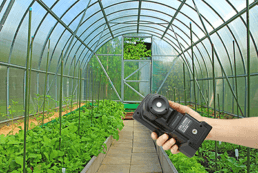Measuring Light in Greenhouses with the CL-500A Illuminance Spectrophotometer
Lack of light can obviously hinder plant growth, but did you know too much light may not be beneficial either? Each species of crop has an optimal light intensity that maximizes photosynthesis and therefore, growth. The most efficient way to manage this is to measure the amount of light the plant is receiving and try to match it to its optimal light intensity. This will minimize both the expense of lost crop production and excess cost of keeping lights on unnecessarily.
In order to determine the most efficient use of light, a reading known as the Daily Light Integral received by the crops must be monitored and adjusted. Similar to the way a rain gauge measures rain, the DLI measures the amount of photosynthetically active radiation received in a day. Plants generally fall into four categories of DLI requirement – low, medium, high, and very high. As an example, a fern is a low-light plant that demands a very minimal DLI in order to thrive.
Some farmers even choose to separate crops by their DLI requirement to maximize efficiency with supplemental lighting, if needed. Such as the case in the Northern United States where there is a large portion of the year in which the light is not sufficient for most crop growth. In light-limiting conditions, artificial lighting is used to increase photosynthesis and yield a higher production of crops.
One way light can be measured is with a light meter, such as Konica Minolta Sensing’s CL 500A. With the CL-500A illuminance spectrophotometer, a spectral irradiance is measurable in distances of 1 nm from 360 to 780nm. This photosynthetically active radiation light wavelength falls within this range and can be gauged with the CL-500A illuminance spectrophotometer, or any other similar light meter. An individual crop’s ideal DIL can then be decided and the lighting within the greenhouse can be set to achieve the optimal amount of crop or flower growth.
Like this article? Click here to sign up for our monthly Light Trends & Technology newsletter to learn more about the research, evaluation, and measurement of light. By subscribing, you will stay up to date on the latest information on high-quality optical test and measurement instruments and special offers including seminars, webinars, and exclusive promotions.
The technological leader in color and light measurement solutions, Konica Minolta Sensing Americas helps organizations formulate, evaluate, and control color to meet product quality and operational goals more efficiently.
Visit our Lighting Industry Solutions page to see a full line of available instruments from Konica Minolta Sensing’s lighting product line to find solutions for research and development, design, production, quality control, installation, and field verification.










